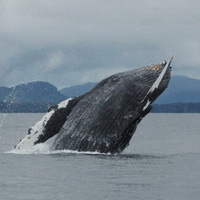 |
Humpback Whale Fluke Poster Please contact us at alaskahumpbacks@gmail.com for more information on purchasing a poster to help support whale research in southeastern Alaska.
|
When a humpback whale dives, the tail rises into the air showing a distinct shape and coloration unique to each whale. Using photography, researchers capture this image to identify each whale. This website is a collection, or catalog, of the best photographs of nearly 1900 different humpback whales seen in southeastern Alaska across the past three decades.
Photographs were collected by 16 different research groups. Three groups contributed most of the photographs in the catalog: J. Straley Investigations, University of Alaska and Glacier Bay National Park. These long term studies provide some of the most comprehensive information on humpback whales in the world today.
Photographs were collected primarily in three areas of northern southeastern Alaska: Sitka Sound on the western side of Baranof Island, Frederick Sound south of Admiralty Island, and Glacier Bay/Icy Strait. Place your mouse over the map below to highlight the different study areas.
 |
 |
|||||||||||||
 |
||||||||||||||
 |
 |
|||||||||||||
 |
 |
|||||||||||||
 |
||||||||||||||
Researchers use photographs to tell a story about each whale. This story, or sighting history, documents when and where each whale has traveled. These findings are used to determine movements of individual whales, who they are traveling and feeding with, when a female has a calf and how many whales use these waters to feed. By compiling thousands of these sightings, we have improved our understanding of the natural history and biology of humpback whales.
Click here to learn more about humpback whales, how scientists study them or to view the catalog.
 |
 |
|---|
This website is based upon work supported by the National Institute of Food and Agriculture, U.S. Department of Agriculture, under Award No 07-04028. Any opinions, findings, conclusions, or recommendations expressed in this publication are those of the author(s) and do not necessarily reflect the view of the National Institute of Food and Agriculture, U.S. Department of Agriculture.
 |





